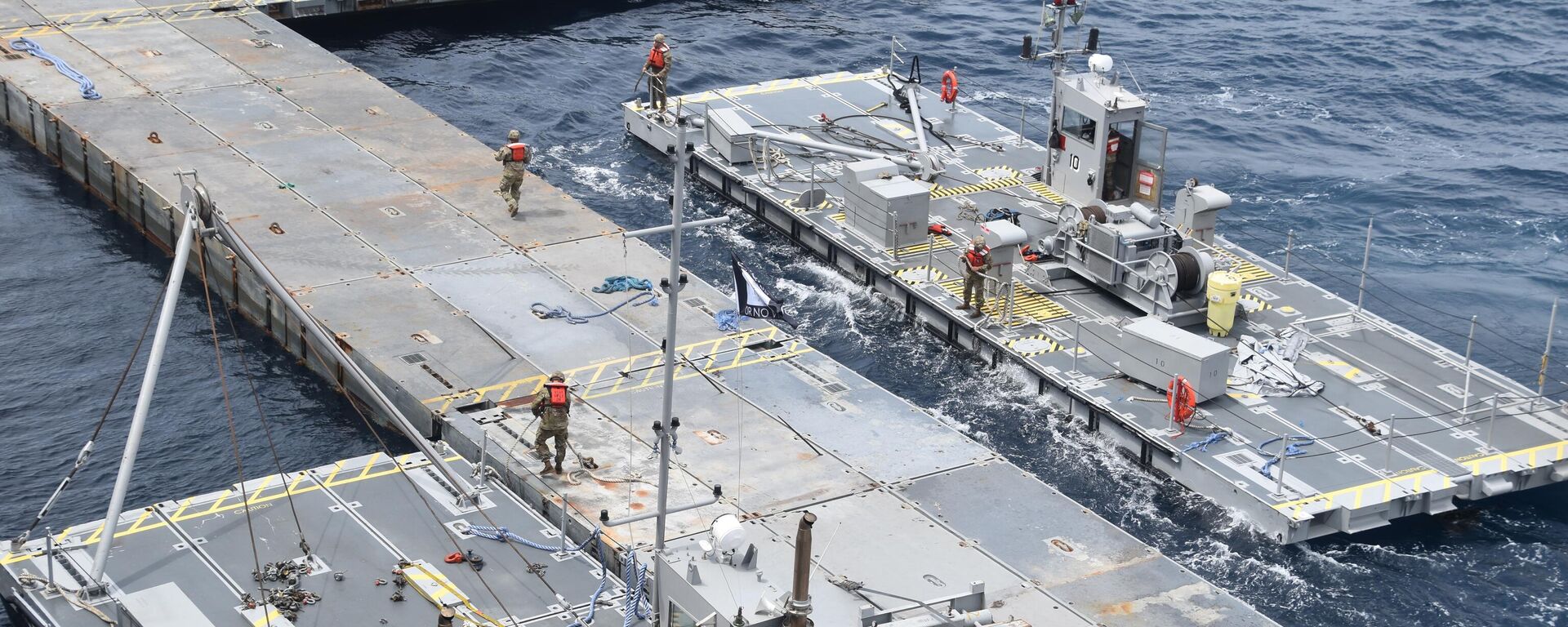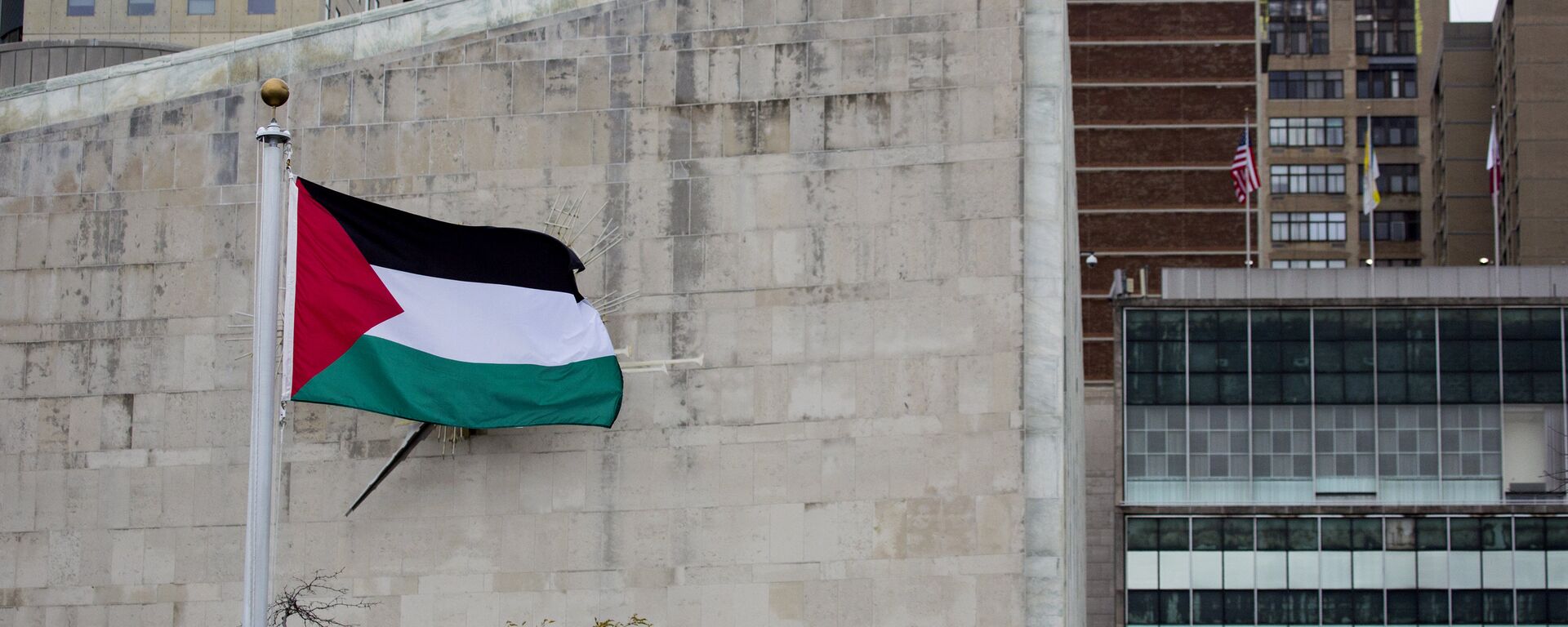https://sputnikglobe.com/20240523/gaza-pier-used-to-feed-idf-before-palestinians—journalist-1118607826.html
Gaza Pier Used to Feed IDF Before Palestinians – Journalist
Gaza Pier Used to Feed IDF Before Palestinians – Journalist
Sputnik International
The US is sending weapons and food to the IDF before feeding Palestinians with its temporary pier, a journalist with sources on the ground in Gaza told Radio Sputnik on Thursday.
2024-05-23T23:56+0000
2024-05-23T23:56+0000
2024-05-23T23:56+0000
analysis
palestinians
un office for the coordination of humanitarian affairs (ocha)
jens laerke
israel
palestine
joe biden
middle east
pentagon
pier
https://cdn1.img.sputnikglobe.com/img/07e8/03/08/1117212736_0:0:3067:1725_1920x0_80_0_0_976e41e5a9ae368266c61180a3a4c80e.jpg
According to a journalist with sources on the ground in Gaza, the US-built pier that was constructed off the coast of Gaza ostensibly to bring in aid for hungry Palestinians was first used to bring in military equipment and then food, but the first batches of food went to Israeli Defense Force (IDF) soldiers and not the starving citizens of Gaza.Leila Hatoum was a guest on Sputnik’s Fault Lines on Thursday, where she described the current situation with the controversial pier.Critics have questioned the US’ intentions in building the pier since US Joe Biden announced the plan during a State of the Union address in March. The $320 million pier is only capable of bringing in 150 aid trucks daily, according to US officials, though some doubt it is even that much. Aid organizations estimate that Gaza needs at least 500 trucks a day to feed the population. That has led many organizations to declare it a complicated and costly distraction when the easier solution would be for Israel to allow aid to flow through land routes.Some have also pointed to nearby Israeli military bases and the significant natural gas reserves off the coast of Gaza as potential alternative motivations for the US.The US has described the pier as temporary.On Wednesday, the Pentagon admitted that none of the aid that had gone through the pier made it to the Palestinian population, blaming hungry Palestinians for intercepting the trucks. On Thursday, the US Central Command announced that three US troops suffered non-combat injuries during the mission, including one who “was medivac” but declined to provide further details.Even if the pier begins running at full capacity, the UN Office for Coordination of Humanitarian Affairs (OCHA) has repeatedly emphasized that it will not be enough and Israel must open land routes to allow aid in.“Getting aid to people in need into and across Gaza cannot and should not depend on a floating dock far from where needs are most acute,” OCHA spokesperson Jens Laerke said.On Monday, the special prosecutor for the International Criminal Court (ICC) announced their intention to seek an arrest warrant for Israeli Prime Minister Benjamin Netanyahu and several other high-ranking Israeli officials. On Wednesday, Norway, Spain and Ireland announced that they will formally recognize Palestine as a state later this month, bringing the total number of UN member states that recognize Palestine to 146 out of the 193 members of the General Assembly. However, the addition is significant because many of the holdouts are in Western Europe.While the decision was condemned by Israel, Hatoum argues the European nations are trying to salvage what they can of the state of Israel.“They are trying to save the Israeli entity. Israel at the moment is under immense pressure and it’s in trouble. It hasn’t recorded any victories in the past eight months,” she explained. “October 7th established one of two things. Either the speeding of a two-state solution, or we will not see the Israeli entity as we used to.”
https://sputnikglobe.com/20240507/is-biden-pushing-for-another-nakba-with-gaza-aid-pier-ploy-1118298323.html
https://sputnikglobe.com/20240523/israel-faces-diplomatic-defeat-as-european-countries-recognize-palestinian-state-1118593502.html
israel
palestine
2024
News
en_EN
https://cdn1.img.sputnikglobe.com/img/07e8/03/08/1117212736_190:0:2919:2047_1920x0_80_0_0_df72e03fc8c4993ad2661c369fdbf586.jpg
temporary pier in gaza, aid to gaza, gaza genocide, rafah crossing closed, famine in gaza,
temporary pier in gaza, aid to gaza, gaza genocide, rafah crossing closed, famine in gaza,
Earlier this month, Israel seized the Palestinian side of the Rafah border crossing in Gaza, the main crossing between Gaza and Egypt. Since that time, humanitarian aid coming into Gaza has slowed to a crawl, despite the much-hyped US-built pier constructed off the coast.
According to a journalist with sources on the ground in Gaza, the US-built pier that was constructed off the coast of Gaza ostensibly to bring in aid for hungry Palestinians was first used to bring in military equipment and then food, but the first batches of food went to Israeli Defense Force (IDF) soldiers and not the starving citizens of Gaza.
“The first batch of trucks that came in, they had weapons, they didn’t have aid. There were a few trucks that came in that actually had some aid, but they didn’t go to the north [where hunger is worst in Gaza.] They went over to the [IDF] base near the Netzarim corridor to the American and Israeli soldiers,” Hatoum, who is the editor and chief for MENA Uncensored explained. “And there was some aid that when the Palestinians approached to take them from the trucks, they were shot at. This is what the US is doing and in their media, they’re trying to insinuate otherwise.”
Critics have questioned the US’ intentions in building the pier since US Joe Biden announced the plan during a State of the Union address in March. The $320 million pier is only capable of bringing in 150 aid trucks daily, according to US officials, though some doubt it is even that much. Aid organizations estimate that Gaza needs at least 500 trucks a day to feed the population. That has led many organizations to declare it a complicated and costly distraction when the easier solution would be for Israel to allow aid to flow through land routes.
Some have also pointed to nearby Israeli military bases and the significant natural gas reserves off the coast of Gaza as potential alternative motivations for the US.
“[Israel and the US] are not opening borders. They have stopped the airdrops and they’ve been fixating everything on that port. Why?” Hatoum asked. “What are they getting through that port? It’s heavily, heavily guarded by the Israeli and US militaries,” she added, noting that they have created an 8km by 3km area that no one is allowed to enter.
The US has described the pier as temporary.
On Wednesday, the Pentagon admitted that none of the aid that had gone through the pier made it to the Palestinian population, blaming hungry Palestinians for intercepting the trucks. On Thursday, the US Central Command announced that three US troops suffered non-combat injuries during the mission, including one who “was medivac” but declined to provide further details.
Even if the pier begins running at full capacity, the UN Office for Coordination of Humanitarian Affairs (OCHA) has repeatedly emphasized that it will not be enough and Israel must open land routes to allow aid in.
“Getting aid to people in need into and across Gaza cannot and should not depend on a floating dock far from where needs are most acute,” OCHA spokesperson Jens Laerke said.
“Land routes are the most viable, effective and efficient aid delivery method, which is why we need all crossing points to be opened,” he added.
While the decision was condemned by Israel, Hatoum argues the European nations are trying to salvage what they can of the state of Israel.
“They are trying to save the Israeli entity. Israel at the moment is under immense pressure and it’s in trouble. It hasn’t recorded any victories in the past eight months,” she explained. “October 7th established one of two things. Either the speeding of a two-state solution, or we will not see the Israeli entity as we used to.”



